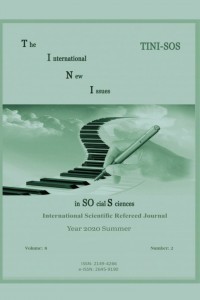MALZEME AKIŞ MALİYET MUHASEBESİ UYGULAMA ADIMLARI, HEDEF VE İLKELER
Malzeme Akış Maliyeti Muhasebesi, Çevre Muhasebesi, Atık Muhasebesi
MATERIAL FLOW COST ACCOUNTING IMPLEMENTATION STEPS, OBJECTIVES AND PRINCIPLES
___
- Asian Productivity Organization, (2014), Manual On Material Flow Cost Accounting: ISO 14051, Tokyo
- IFAC (International Federation of Accountants), (2005), International Guidance Document on Environmental Management Accounting. IFAC, New York.
- International Organization for Standardization (ISO), (2011), ISO 14051: Environ- mental Management: Material Flow Cost Accounting: General Framework. International Organization for Standardization, Geneva, Switzerland, 15 September 2011.
- Jasch, C., (2003b), The use of Environmental Management Accounting (EMA) for identifying environmental costs. J. Clean. Prod. 11, 667-676.
- Jasch, C., (2011), Environmental management accounting: comparing and linking requirements at micro and macro levels e a practitioner's view. In: Burritt, R.L., Schaltegger, S., Bennett, M., Pohjola, T., Csutora, M. (Eds.), Environmental Management Accounting and Supply Chain Management. Springer, pp. 255-277.
- Jasch, C., Savage, D.E., (2008), The IFAC international guidance document on envi- ronmental management accounting. In: Schaltegger, S., Bennett, M., Burritt, R.L., Jasch, C.M. (Eds.), Environmental Management Accounting for Cleaner Pro- duction. Springer, pp. 321-336.
- Jindrichovska, I., Purca˘rea, I., (2011), CSR and environmental reporting in the Czech Republic and Romania: country comparison of rules and practices. Account. Manag. Inform. Syst. 10, 202-227.
- Kokubu, K., Campos, M.K.S., Furukawa, Y., Tachikawa, H., (2009), Material Flow Cost Accounting with ISO 14051, pp. 15e18. ISO Insider. Januarye February 2009.
- Kokubu, K., Tachikawa, H., (2013), Material flow cost accounting: significance and practical approach. In: Kauffman, J., Lee, K.-M. (Eds.), Handbook of Sustainable Engineering. Springer, Netherlands, pp. 351-369.
- METI, (2007), Guide for Material Flow Cost Accounting, Tokyo.
- Ministry of Economy, Trade and Industry (METI), (2007), Guide for Material Flow Cost Accounting. Ministry of Economy, Trade and Industry. Version 1. March 2007.
- Okafor, N. (2011), The Disposal of Municipal Solid Wastes. In: N. OKafor, ed. Environmental Microbiology of Aquatic and Waste Systems . Netherlands: Springer: 275-303.
- Onishi, Y., Kokubu, K., Nakajima, M., (2009), Implementing material flow cost ac- counting in a pharmaceutical company. In: Schaltegger, S., Bennett, M., Burritt, R.L., Jasch, C.M. (Eds.), Environmental Management Accounting for Cleaner Production. Springer, pp. 395-409.
- Papaspyropoulos, K.G., Blioumis, V., Christodoulou, A.S., Birtsas, P.K., Skordas, K.E., (2012), Challenges in implementing environmental management accounting tools: the case of a nonprofit forestry organization. J. Clean. Prod. 29-30, 132-143.
- Schmidt, M., Nakajima, M., (2013), Material flow cost accounting as an approach to improve resource efficiency in manufacturing companies. Resources 2, 358-369.
- Schrack, D., Prammer, H.K., (2013), Integration of external costs and environmental impacts in material flow cost accounting e a life cycle oriented approach. In: Guenther, E., Bergmann, A. (Eds.), Proceedings from the EMAN-EU 2013 Conference on Material Flow Cost Accounting. Springer, Singapore, pp. 150-154.
- Seadon, JK. (2010) Sustainable waste management systems. Journal of Cleaner Production, 18(16/17): 1639-1651.
- Trappey, A.J., Yeh, M.F., Wu, S.C.-Y., Kuo, A.Y., (2013), ISO 14051-based Material Flow Cost Accounting system framework for collaborative green manufacturing. In: 2013 IEEE 17th International Conference on Computer Supported Cooperative Work in Design (CSCWD), pp. 639-644.
- Yakhou, M and Dorweiler, VP. (2004), Environmental Accounting: An essential component of business strategy. Business Strategy and the Environment, 13: 65-77.
- ISSN: 2149-4266
- Yayın Aralığı: Yılda 2 Sayı
- Başlangıç: 2015
- Yayıncı: Orhan KÜÇÜK
Örgüt Kültürü, İşgören Performansı ve İşletme Performansı Arasındaki İlişkilerin Belirlenmesi
Psikolojik Sözleşme ve Örgütsel Sessizlik Arasındaki ilişki
Tekstil Sektöründe 5S Uygulaması: Bir Vaka Çalışması Örneği
A Comparison of an Education Organizational Structure: Libya and Qatar
The relationship between logistics performance and business performance
MALZEME AKIŞ MALİYET MUHASEBESİ UYGULAMA ADIMLARI, HEDEF VE İLKELER
